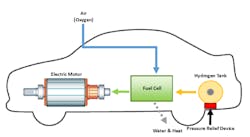Hydrogen Fuel Cell Vehicles—What First Responders Need to Know
With the automotive industry investing heavily in clean fuel vehicles, it is important to understand the risks associated with some of the new technology on the market. In this article, we will be exploring hydrogen fuel cell electric vehicles (HFCEVs).
How it works
To understand the risks, we must first understand how they work. Figure 1 illustrates the process undergone to transform hydrogen fuel into energy. Hydrogen is passed into the fuel cell along with air. Inside the fuel cell, the hydrogen atom is split into protons and electrons. The electrons, and specifically the steady flow of electrons, are the electricity used to operate the electric motor that drives the vehicle. While the fuel cell is producing electricity, the protons from the hydrogen combine with oxygen from the air to produce water.
The only exhaust that HFCEVs produce is water vapor. HFCEVs are electric vehicles, so most HFCEVs don’t employ any backup power systems that run off of other fuels. This means that HFCEVs do not have a gasoline or diesel storage tank on board. While the cost of hydrogen is dependent on transportation and generation methods, it is competitive with that of gasoline and can be cheaper.
Know the risks
With any new technology, it is important to understand the associated risks. While HFCEVs do run off hydrogen, the chance of fire or explosion is extremely low. Hydrogen is a stable fuel source and its properties are well understood due to extensive use in industrial processes. The vehicles are designed with a thermal pressure relief device (TPRD) on the tank that would discharge if the car was engulfed in a fire.
If a fuel leak were to occur, the hydrogen would disperse upward rapidly, and if the TPRD were activated, the tank would discharge in a matter of minutes. Because of how quickly hydrogen disperses, whether in open air or an underground garage, the only location where a flammable environment could occur is at the discharge point, unless there is containment of the release while the hydrogen is still in the flammable range. If the discharge of hydrogen was ignited by an outside source, it would burn for a much shorter time then gasoline, and at a temperature of nearly 2,000 degrees C.
While this is a relatively high temperature, it is important to note that what burns in a car fire is largely the combustible material on the car itself. This includes tires, upholstery, etc. While hydrogen itself does burn hotter than other common fuels, there have been burn trials with HFCEVs parked in close proximity to typical combustion engine vehicles to test the possibility of fire spreading due to a car fire on an HFCEV. It was found that if an outside source ignited an HFCEV, the spreading of the fire from the HFCEV to a standard internal combustion engine vehicle was due to the flammable material on the car igniting as opposed to the TPRD activating and producing a hydrogen flame.1
HFCEVs are outfitted with a wide range of sensors in the name of safety. In the event of a fuel leak or impact, HFCEVs are automatically programmed to shut down into a fail-safe mode. This means that the fuel system will not operate and will not be able to be turned back on by restarting the car. If for whatever reason the vehicle does not shut down, the only “emergency” shutdown that could be initiated is by physically turning off the vehicle.
It is recommended that if there is a hydrogen leak present, and the vehicle is still on, to treat the situation as you would with any other flammable gas and establish a safe perimeter. It is important to remember that HFCEVs are electric vehicles, and battery cables can be cut to prevent airbag ignition the same way they can be on standard electric vehicles. As stated, the fuel system should shut down in a fail-safe mode anyway, so no additional safety hazard will be created by cutting the battery lines.
In the event of a particularly catastrophic accident, evaluating the system may be made more difficult due to the fact that the fail-safe shutdown mechanism may not have had time to react. In an event like this, it is always important to proceed with extreme caution. Likely, in this case, hydrogen will be released and holds the potential for ignition. Depending on if high powerlines have been broken or not, there is potential for shock hazard and encountering energized metal and equipment. These situations are difficult to plan for and should be handled on a case-by-case basis.
In sum
HFCEV are no less safe on the road than traditional internal combustion engine vehicles; they just present a different set of risks. As HFCEVs increase in popularity, it is important to make sure our first responders are well informed regarding what to expect from this new technology in emergency situations. While currently limited to California and the East Coast, the HFCEV market is growing. Awareness and understanding is key to safely and responsibly integrating this emerging, environmentally friendly technology into society.
More information on first response and safety regarding alternative fuel vehicles can be found on the NFPA Alternative Fuel Vehicles Safety Training website.
Sources
1. Tamura, Y, Takabayashi, M, Takeuchi, M. The spread of fire from adjoining vehicles to a hydrogen fuel cell vehicle. International Journal of Hydrogen Energy. Vol. 39, Issue. 11. April 2014. sciencedirect.com/science/article/pii/S0360319914002201.
2. Hydrogen Tools: https://h2tools.org.
About the Author
Kara Schmidt
Kara Schmidt is an electrical engineering intern with the Transportation & Hydrogen Systems Center, National Renewable Energy Lab.
Joshua Schmidt
Joshua Schmidt is a firefighter-paramedic with the Grapevine Fire Department in Texas.
Carl Rivkin
Carl Rivkin is the safety research team lead with the Transportation & Hydrogen Systems Center, National Renewable Energy Lab.
